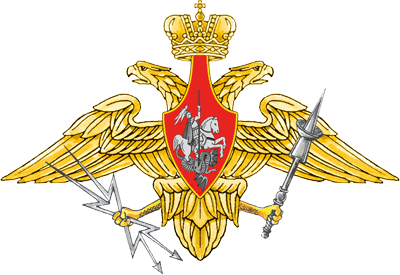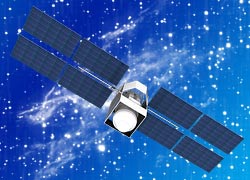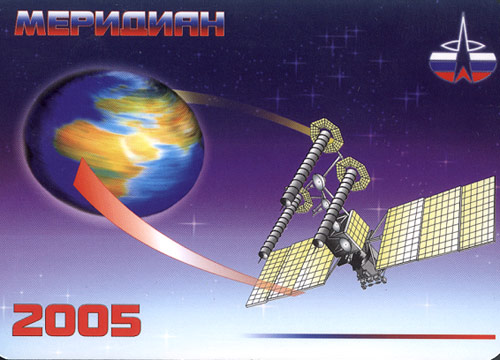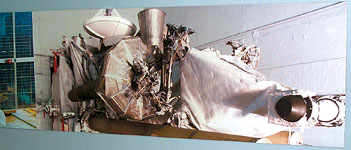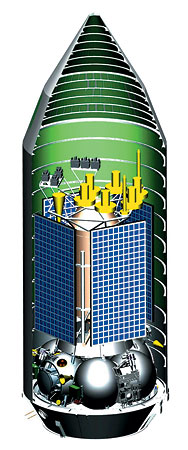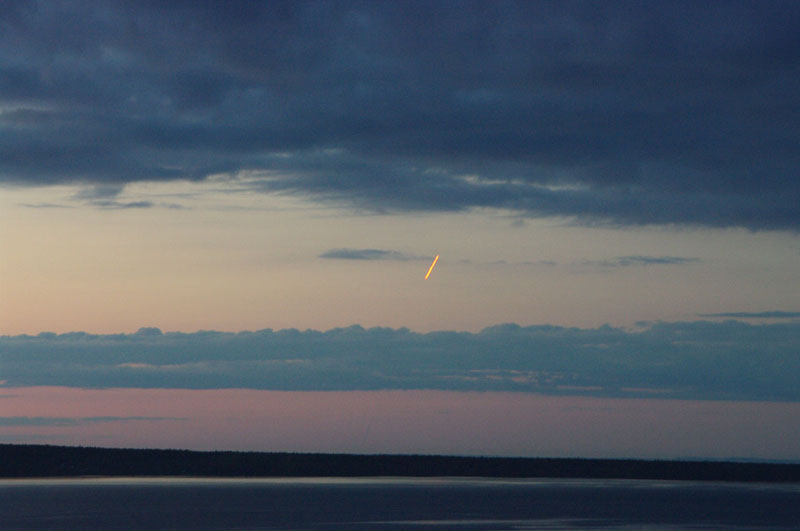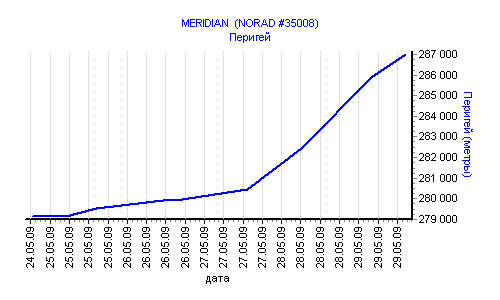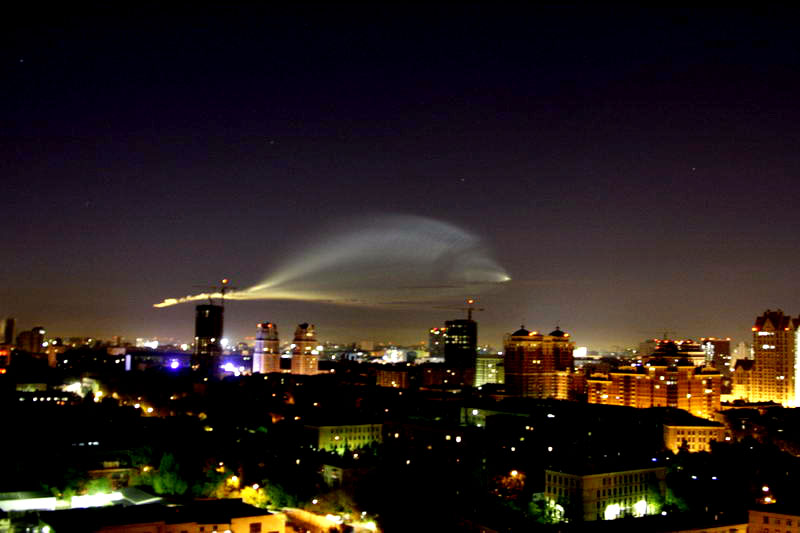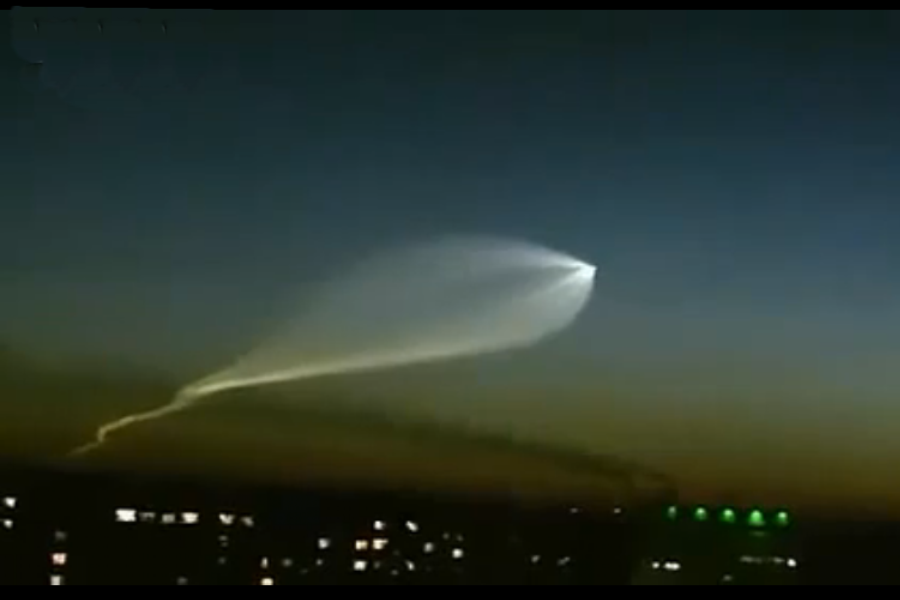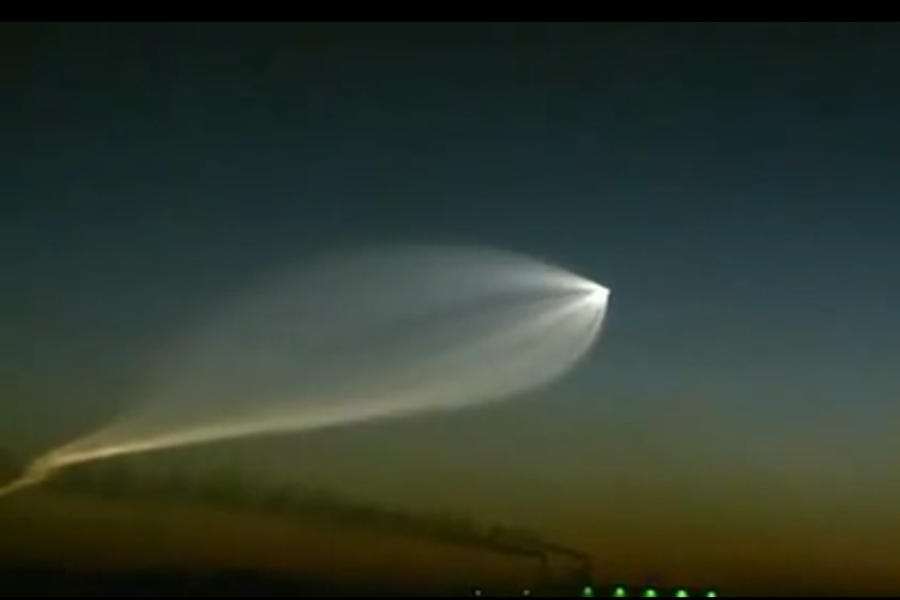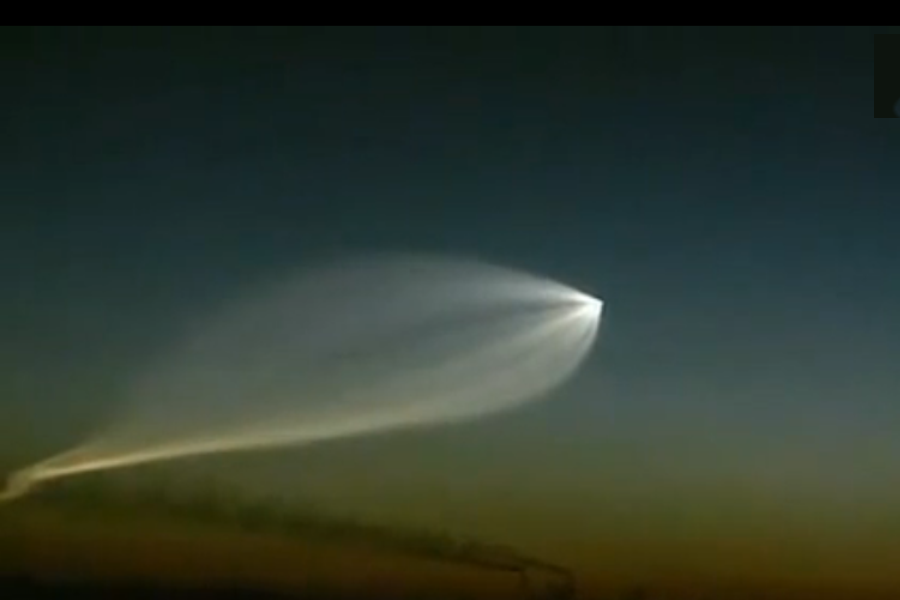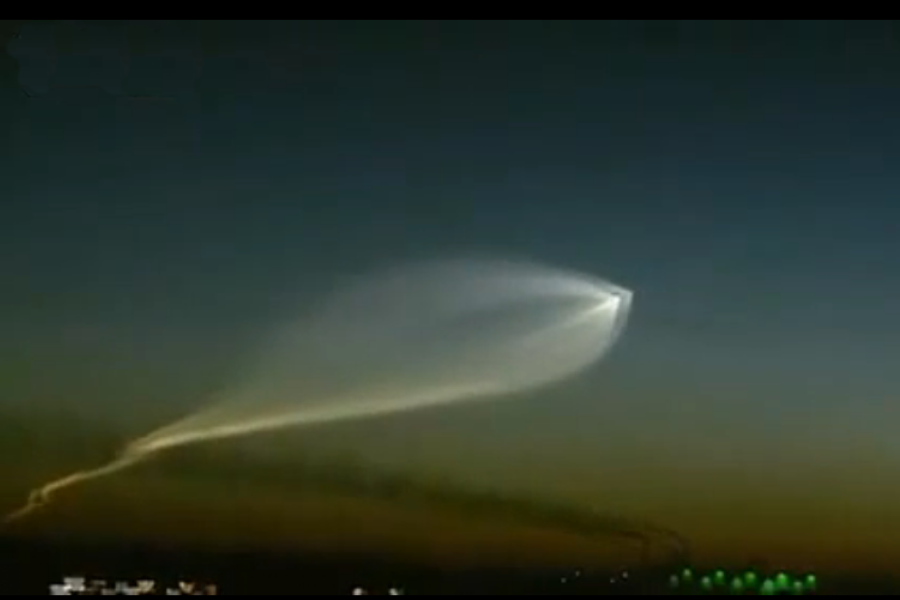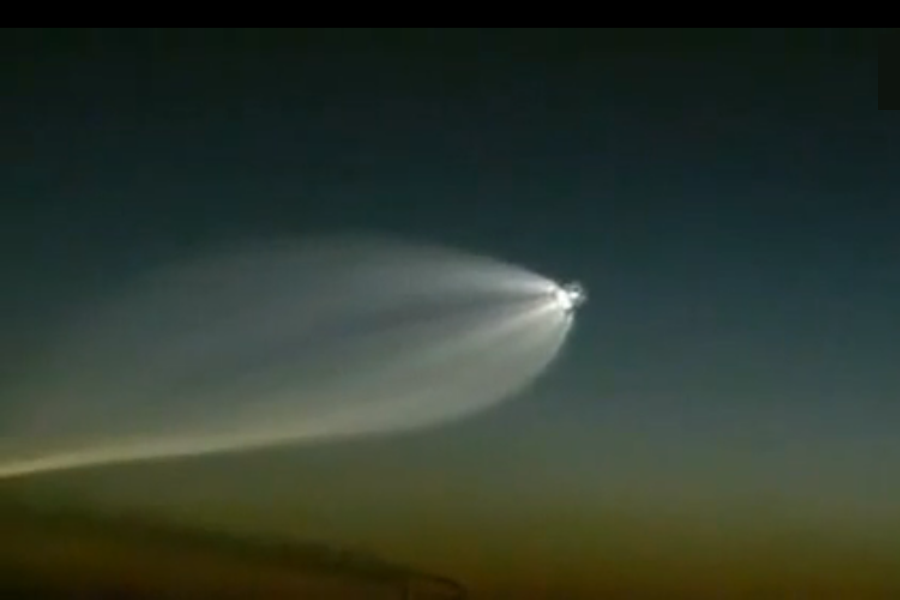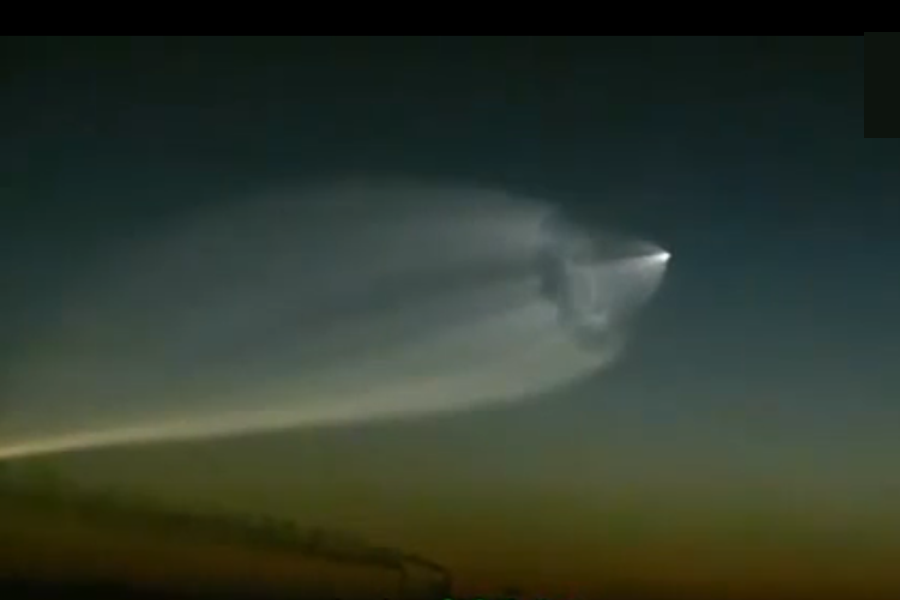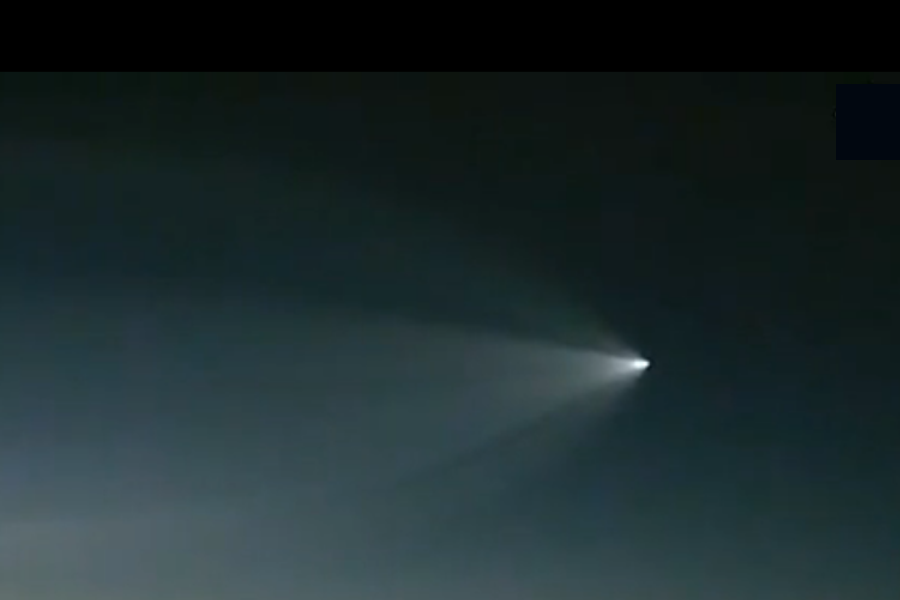|
The UFO Files False UFO Sightings |
|||||||||||||||||||||||||||||||||||||||||
|
Launch site: Plesetsk Launch date: May 22, 2009
The launch time is:
Payload: Meridian military communications satellite Spacecraft: Meridian (14F112) (meaning Meridium) The available images vary:
Manufacturer: JSC "Information Satellite Systems Reshetnev Company"
Meridian series satellites serve as a part of the United System of Satellite Communications 2nd generation (USSC-2) used by various governmental agencies of Russia, including the armed forces. Placed in a Molniya orbit, it provides high latitude transponder coverage, while Raduga class satellites residing in the GEO, provide global coverage. Meridian is viewed upon as a replacement for the older Molniya-3 spacecraft class. It is believed to have a pressurized hull part and overall design similar to Uragan-M class satellites that are currently employed as the mainstay of the GLONASS navigation system. Unlike Molniya series that only worked in the solar-facing attitude, the Meridian has full 3-axis stabilisation and rotating solar arrays. Meridian satellites reside in Molniya orbits (900 km x 39000 km; 65°) Launcher: Soyuz-2-1A with Fregat upper stage
“Soyuz-2” launch vehicle
is a current generation R-7 family launch
vehicle. It is a replacement
for “Soyuz-U”, “Soyuz-FG” and “Molniya-M” launch
vehicles.
“Soyuz-2” launch vehicle with “Fregat” upper
stage can launch spacecrafts
to various orbits: low, medium, high elliptical,
sun-synchronous, GTO and
GSO. Its main distinctions from the Soyuz-FG are
new injectors on Stage
I-II eniges, a digital flight control system,
digital data downlink, deorbitable
stage III and a new payload fairing. It's
capable of launches from modified
R-7 launch complexes.
Manufacturer: Samara Space Centre
It can deliver up to 6830 kg of payload into 220*220 km circular orbit with inclination of 62.8° when launched from Plesetsk.
Manufacturer: NPO Lavochkin The dry mass of a Fregat (as of October 2006) is 924 kg; with fuel the mass is up to 5350 kg. Current modification of the main engine has a specific impulse of 332 s and a thrust of 2018 kg. The reaction control system includes 12 engines, each having 5 kg thrust, 225 s Isp, using pure hydrazine, with mass up to 42 kg. The vehicle's reliability statistics according to http://www.spacelaunchreport.com/reliability2009.txt: Code:
Launch Profile
After a 9 min long boosting stage, the payload assembly is put into 62.8° inclined initial orbit with mean altitude of 210 km. After a 15 min long coasting, a second Fregat's 613 seconds long burn puts the payload into a transfer orbit. After reaching the apogee, the orbit's shape is finalized. Weather forecast for Plesetsk, Russia on May 21, 2009
Watching the launch live
UPDATE A successful launch of Meridian satellite has been reported by Russian Space Force. The launch occurred on time off the Soyuz Launch Complex 4 at the site 43 of Plesetsk Cosmodrome: The spacecraft separation was reported at 04:13 Moscow Local Time (00:13 UTC on May 22, 2009). NORAD is tracking two objects in the similar orbit, it appears that Meridian is NORAD# 35008, in 276 x 36 474 km orbit with inclination of 62.836° and period 10h 45m 56s (645.93 min). The orbit looks funny in Orbitron, as it's expected for Molniya orbits: ---------- Post added at 11:54 ---------- Previous post was at 11:48 ---------- The launch video (unfortunately, Rutube won't embed here, so please follow the link). The sight is worthy of listening through the first part. http://rutube.ru/tracks/1929909.html?v=bc779a301e73730efd645bad31d231f1 ---------- Post added at 14:26 ---------- Previous post was at 11:54 ---------- Official messages aside, it looks like we've got here at least a partial failure situation. During the past Meridian launch:
This gives about
114 m/s Delta V lacking for the intended
working orbit. Combined with the information of the
possible premature
Fregat separation, it looks very much like the
Fregat's failure shortly
before the end of the perigee burn (so severe they
had to jettison the
thing)!
It's not very much clear if the spacecraft possesses the necessary Delta V reserve or if it's OK for it to function in the orbit it's in.Nevertheless, here are several launch pictures made by observers from distance. As was seen from Pertrozavodsk (the view across the Onega lake):
As was seen from Vologda (with better optics, evidently):
There are also reports of this launch being visible from Moscow as well (I'm really sorry that I've missed the show). ---------- Post added at 17:40 ---------- Previous post was at 14:26 ---------- As the latest news go, the third stage of the Soyuz LV has cut off 3 seconds short of the intended MECO. The Fregat tried as hard as it could to deliver the payload to the bulls eye, but simply ran its tanks dry trying. I guess the sat is still useful for providing the communication services for ships and airplanes in Arctics, although it may have a reduced lifetime. It looks like the satellite's controllers are raising its perigee by a hair at a time:
And here's one more launch picture, this time taken in Moscow:
The preliminary conclusion on the failure cause is like the following: The problem was caused by incorrect input of the payload data into the Fregat upper stage's flight program due to discrepancy of communications between Contractor and Customer. This has caused overconsumption of propellant during the 1st and 2nd Fregat's burns. The 2nd burn cut off preliminary at the low fuel sensor's action. This emergency situation automatically triggered payload separation, which is what happened. Meanwhile, two tiny burns were performed up to date in attempt to make the satellite's orbit closer to the intended values; http://radikal.ru/F/s49.radikal.ru/i125/0906/ce/4ffcdb9583f5.gif.html As the wording of what I read went, there was no difference in the Fregat's propellant reserve. The only tuning they did was altering values in the upper stage's flight computer's program, and the values put in did not suit the actual payload. I can only wonder actually what values might have been there. A closest approach may be thinking that Fregat's engine supports burning at different thrust levels, each one having it's own ISP. And they've burnt out too much in the first two burns. I am not sure of this, though. The top question currently is whether it was Customer who supplied the wrong data to the Contractor or the Contractor's problems with hearing or vision. I don't know if they are going to leak out any more information, or, to everybody's surprise, release something officially. The official line is that the
satellite is launched,
period.
SOURCE: Posted and
researched by SiberianTiger
|
|||||||||||||||||||||||||||||||||||||||||
|
Летающее что-то May 22, 2009 .. Youtube Link |
|||||||||||||||||||||||||||||||||||||||||
|
No Baikonur Cosmodrome in Kazakhstan Carrier Rocket Soyuz-U - Cargo Ship Progress M-06M This originally came from this link: http://youku.soufun.com/Video/VInfoDetail_20119090_0_12420743.htm but the server was slow. I am not sure whether this is the same object which caused the disruption over Xiaoshan Airport. UFO Closes China's Xiaoshan Airport!
STOP PRESS:
Uploaded on Jul 10, 2010 On Wednesday night in the sky over
the capital city of Bishkek, Kyrgyzstan appeared an unidentified flying
object, which later disappeared in a bright flash. Experts in the space
industry was assured that this incident has nothing to do with the
launch of a rocket Baikonur. According to eyewitnesses, the UFO remotely
resembled a comet. He moved, leaving behind a glowing trail in the sky,
reports RIA Novosti . After some time, an explosion, and on-site by an
unknown object have only a silver cloud. It can be observed with the
naked eye for about an hour. Note that the unusual phenomenon coincided
with the launch from the Baikonur Cosmodrome in Kazakhstan, the carrier
rocket Soyuz-U. It must deliver to orbit cargo ship Progress M-06M " .
According to experts, the appearance of UFOs over Bishkek and missile
launch does not interconnected. |
|||||||||||||||||||||||||||||||||||||||||
|
Carrier Rocket Soyuz-U - Cargo Ship Progress M-06M
|
|||||||||||||||||||||||||||||||||||||||||
|
Soyuz-U - Progress M-06M
.Filled
with trash and discarded items, the unpiloted
ISS Progress 38 supply vehicle
departs from the International Space Station at
7:22 a.m. (EDT) on Aug.
31, 2010. Russian flight controllers will
conduct thruster tests with the
Progress to gather engineering data until it is
deorbited and burned up
in Earth's atmosphere over the Pacific Ocean.
Its departure clears the
way for the arrival of the next Russian resupply
vehicle, ISS Progress
39, which will launch Sept. 8 and dock Sept. 10,
delivering 2.5 tons of
food, fuel and supplies for the Expedition 24
crew. Date: 31 August 2010.
Progress M-06M The Soyuz-U rocket used to launch the Progress M-06M spacecraft was delivered to the Baikonur Cosmodrome in early March 2010. The rocket was manufactured by TsSKB-Progress at Samara. The Progress was launched successfully on 30 June 2010 at 15:35 UTC. The cargo ship was loaded with 870 kilograms (1,900 lb) of propellant, 50 kilograms (110 lb) of oxygen and air, 100 kilograms (220 lb) of water and 1,210 kilograms (2,700 lb) of equipment, spare parts and experiment hardware. The spacecraft reached a preliminary orbit of 193 by 241 kilometres (120 by 150 mi). A series of precise engine firings over two days guided the craft towards a docking with the International Space Station's aft Zvezda port originally scheduled for 2 July. Source: Wikipedia Progress M-06M Related Links:
|
|||||||||||||||||||||||||||||||||||||||||
|
Caught on Film November 02, 2010
Yekaterinburg seen today above the
city flight rocket
(PHOTOS)
Yekaterinburg, November 02 (New Region, Ignat Bakin) - Glowing flying object seen today in the early morning by the inhabitants of Yekaterinburg. One of the witnesses, who described what he saw in the blogs, believes that it was a rocket Soyuz-2 "spacecraft" Meridian ", launched from the Plesetsk cosmodrome. As the correspondent of "New Region", the residents of the Urals capital describe the celestial phenomenon as a light blue long line with a wide trail. Gradually glowing boom with divergent triangular rays went from the north-west of the city to the southeast. "It had to be seen live! A unique spectacle, similar to the slowly falling fireballs! "- Says the user under the name 'Ekamag'. A missile flew over Yekaterinburg around six o'clock in the morning, her shining path could be observed for several minutes. One of the townspeople managed to capture the aircraft on his camera. Meanwhile, Federal Space Agency Official Reports of a successful launch from Plesetsk launch vehicle Soyuz-2 "spacecraft" Meridian "that runs in the interests of the Defense Ministry. According to information at the site office, the vehicle was launched today at 03.58 Moscow time and was in normal mode. "Estimated time of separation of the spacecraft from the upper stage" Fregat "- 06.13 MSK in the zone of radio visibility of ground" - the report from the Russian Federal Space Agency. According to open press, "Meridian" - a series of dual-use spacecraft, which serves to link ships and aircraft ice reconnaissance in the northern sea route to coastal land stations, the expansion of satellite communications network of northern areas of Siberia and the Far East for the development of Russian economy. The first device in this series was launched on Dec. 24, 2006 launch vehicle Soyuz-2 ". Start of the second vehicle fired on May 22 last year. Meanwhile, rescuers rush to calm the Urals - falling stages of the spacecraft, as often happens on the border of Perm and Sverdlovsk region after the launch of ballistic missile RS-18 Baikonur Cosmodrome, this time not forthcoming. According to news agency director Karpinski search and rescue team (that area Karpinsk traditionally been chosen as the site for the fall of the missile remnants) Michael Bastron, the trajectory of "Soyuz-2" is somewhat different than that of the RS-18, so the fear of falling from the sky of iron and other elements aircraft is not necessary. "As for the RS-18 - its run, I think, will be implemented next year", - said the rescuer. Related link:
|
|||||||||||||||||||||||||||||||||||||||||
| Originally
posted by JimOberg
from ATS
Post
ID 9849132
If you search google for Ekaterinburg UFO [or in cyrillic, нло Екатеринбург] you'll see a lot of similar images and videos -- and just as the article says, it was a routine rocket launch with over-the-horizon (pre-dawn) sunlight. Just like last December. Sadly, the most
recent bulava missile launches were
not at twilight -- but either full daylight or
midnight darkness --
These UFO-like (how
about we call them 'ufoids'?) apparitions
depend a lot on coincidences of launch time and
lighting conditions, with
cloud cover also a factor, so they've been rare for
decades --
I expect we'll see a video or two from the Urals soon enough. And this particular type of launch also res tarts its engines over south america, sparking mass UFO sightings in Chile, Argentina, and Uruguay for decades, as well -- IF it occurs shortly after local sunset, which THIS launch isn't. |
|||||||||||||||||||||||||||||||||||||||||
| FAIR USE NOTICE: This page contains copyrighted material the use of which has not been specifically authorized by the copyright owner. Pegasus Research Consortium distributes this material without profit to those who have expressed a prior interest in receiving the included information for research and educational purposes. We believe this constitutes a fair use of any such copyrighted material as provided for in 17 U.S.C § 107. If you wish to use copyrighted material from this site for purposes of your own that go beyond fair use, you must obtain permission from the copyright owner. | |||||||||||||||||||||||||||||||||||||||||
|
|
